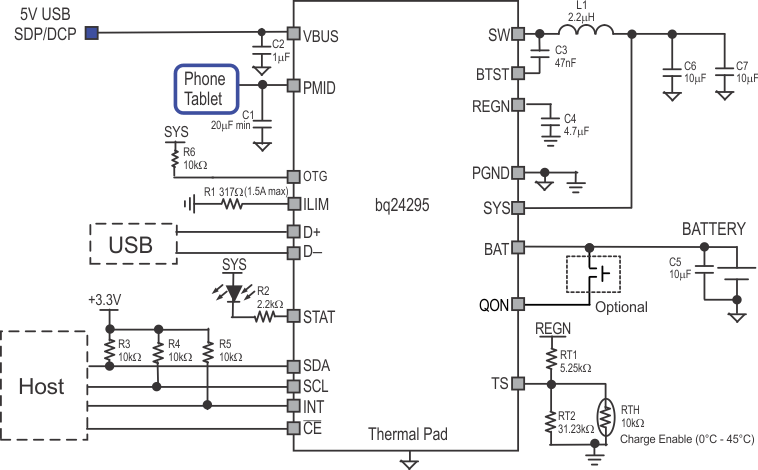ZHCSBL4A September 2013 – January 2015
PRODUCTION DATA.
- 1 特性
- 2 应用
- 3 说明
- 4 修订历史记录
- 5 说明(续)
- 6 Pin Configuration and Functions
- 7 Specifications
-
8 Detailed Description
- 8.1 Overview
- 8.2 Functional Block Diagram
- 8.3
Feature Description
- 8.3.1 Device Power Up
- 8.3.2 Power Path Management
- 8.3.3 Battery Charging Management
- 8.3.4 Status Outputs (STAT, and INT)
- 8.3.5 Protections
- 8.4 Device Functional Modes
- 8.5 Programming
- 8.6
Register Map
- 8.6.1
I2C Registers
- 8.6.1.1 Input Source Control Register REG00 [reset = 01011000, or 58]
- 8.6.1.2 Power-On Configuration Register REG01 [reset = 00011011, or 0x1B]
- 8.6.1.3 Charge Current Control Register REG02 [reset = 00100000, or 0x20]
- 8.6.1.4 Pre-Charge/Termination Current Control Register REG03 [reset = 00010001, or 0x11]
- 8.6.1.5 Charge Voltage Control Register REG04 [reset = 10110010, or 0xB2]
- 8.6.1.6 Charge Termination/Timer Control Register REG05 [reset = 10011100, or 0x9C]
- 8.6.1.7 Boost Voltage/Thermal Regulation Control Register REG06 [reset = 10010011, or 0x93]
- 8.6.1.8 Misc Operation Control Register REG07 [reset = 01001011, or 4B]
- 8.6.1.9 System Status Register REG08
- 8.6.1.10 New Fault Register REG09
- 8.6.1.11 Vender / Part / Revision Status Register REG0A
- 8.6.1
I2C Registers
- 9 Application and Implementation
- 10Power Supply Recommendations
- 11Layout
- 12器件和文档支持
- 13机械封装和可订购信息
1 特性
- 90% 高效开关模式 3A 充电器
- 3.9V 至 6.2V 单输入 USB 标准充电器,提供 6.4V 过压保护
- 与 USB 电池充电器技术规格 (BC1.2) 兼容的 USB 主机或充电端口 D+/D- 检测
- 支持非标准 2A/1A 适配器检测
- 输入电压和电流限制支持 USB2.0 和 USB 3.0
- 输入电流限值:100mA,150mA,500mA,900mA,1A,1.5A,2A 和 3A
- 电池升压模式同步升压转换器,具有以下特性
- 1.5A 时可调输出电压范围为 4.55V 至 5.5V
- 5.1V 升压模式效率为 90%
- 快速 OTG 启动(典型值 22ms)
- 窄范围 VDC (NVDC) 电源路径管理
- 在无电池或深度电池放电时的即时系统启动
- 电池充电模式中的理想二极管运行
- 薄型 1.2mm 电感 1.5MHz 开关频率
- I2C 端口用于实现最优系统性能和状态报告
- 具有或不具有主机管理的自主电池充电
- 电池充电使能
- 电池充电预调节
- 充电终止和再充电
- 高精度
- 充电电压调节范围为 ±0.5%
- 充电电流调节范围为 ±7%
- 输入电流调节范围为 ±7.5%
- 升压模式下 ±3% 输出电压调节范围
- 高集成
- 电源路径管理
- 同步开关 MOSFET
- 集成电流感测
- 阴极负载二极管
- 内部环路补偿
- 安全性
- 针对升压模式中充电和放电的电池温度感测
- 电池充电安全定时器
- 热调节和热关断
- 输入和系统过压保护
- MOSFET 过流保护
- 针对 LED 或主机处理器的充电状态输出
- 通过输入电压调节实现最大功率跟踪能力
- 20µA 低电池泄漏电流,支持运输模式
- 4mm x 4mm 紧凑型超薄四方扁平无引线 (VQFN)-24 封装
2 应用
- 用于智能手机、平板电脑的续航移动电源
- 便携式媒体播放器
- 互联网器件
3 说明
bq24295 是一款高度集成开关模式电池充电管理和系统电源路径管理器件,此器件用于广泛续航移动电源、平板电脑和其他便携式器件应用中的单节锂离子和锂聚合物电池。
器件信息(1)
| 器件型号 | 封装 | 封装尺寸(标称值) |
|---|---|---|
| bq24295 | VQFN (24) | 4.00mm x 4.00mm |
- 如需了解所有可用封装,请见数据表末尾的可订购产品附录。
4 修订历史记录
Changes from * Revision (September 2013) to A Revision
- Added ESD 额定值表,特性描述部分,器件功能模式,应用和实施部分,电源相关建议部分,布局部分,器件和文档支持部分以及机械、封装和可订购信息部分。Go
- Changed bq24295 具有 USB D+/D- 检测功能且用于升压模式充电和放电中的 5.52kΩ,现为 5.25kΩGo
- Changed 整个数据表内的 Power Pad,现为散热焊盘Go
- Changed REG01[5] to REG01[5] = 1 in OTG descriptionGo
- Added (10k NTC thermistor only) to QON descriptionGo
- Changed ICHG = 1792 mA in IICHG_REG_ACC test conditionsGo
- Changed falling to rising and TYP to 47.2% in VHTF in Electrical CharacteristicsGo
- Added VIH_OTG to Electrical CharacteristicsGo
- Deleted wavefroms from Typical Characteristics and added to Application Performance PlotsGo
- Changed Table 3Go
- Added paragraph after Table 3Go
- Changed Figure 15Go
- Changed from 2048 mA to 1024 mA in Table 5Go
- Changed RT1 = 5.25 kΩ Go
- Deleted and LSFET from Voltage and Current Monitoring in Buck Mode descriptionGo
- Changed REG09[5] to REG09[3] in Battery Over-Voltage Protection (BATOVP) sectionGo
- Changed reset = 01100000, or 60 to reset = 00100000, or 0x20 for REG02Go
- Changed Default: 2048 mA (011000) to Default: 1024mA (001000) for bits [7:2] in REG02Go
- Changed reset = 10011010, or 0x9A to reset = 10011100, or 0x9C for REG05Go
- Changed 0 to 1 for REG05 Bit 2 Reset Go
- Changed 1 to 0 for REG05 Bit 1 ResetGo
- Changed REG09 Bit 3 description 1 – Battery OVP Go
- Changed paragraph in Application InformationGo
- Changed 5.52kΩ to 5.25kΩ in Figure 40Go
